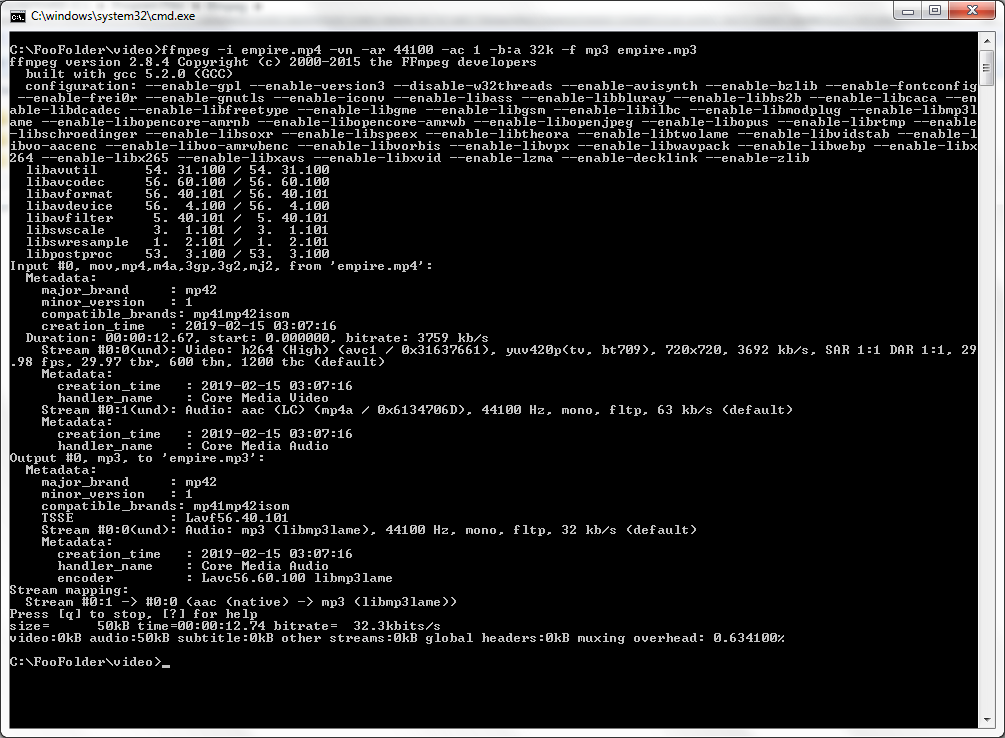

The number and/or type of streams are limited by the container format. In principle, each input/output "file" can contain any number of different types of video streams (video/audio/subtitles/attachments/data). įfmpeg reads and outputs any number of input "files" (can be regular files, pipes, network streams, grab devices, etc.) through the -i option, and writes any number of output "files". The following is the basic command format of FFMPEG: ffmpeg. What follows is the command format and parameters used by FFMPEG to process audio and video Six, the basic format and parameters of the command colors Display the recognized color names. layouts Display channel names and standard channel layouts. sample_fmts shows the available sampling formats. pix_fmts displays the available pixel formats. filters Display available libavfilter filters.

protocols Display the available protocols. bsfs Display available bitstream filters. encoders Display all available encoders. codecs Display all codecs known to libavcodec. formats Display available formats (including devices). The detailed parameter description is as follows: For example, if you want to check which filters are currently supported by FFMPEG, you can use ffmpeg -filters. MPEG can use the following parameters for basic information query.
Ffmpeg copy audio manual#
For full manual control, use the -map option, which disables the default settings just described. You can disable some default settings by using the -vn / -an / -sn / -dn options. In the case where several streams of the same type are equal, the stream with the lowest index is selected. It selects each "best" according to the following criteria: for video, it is the stream with the highest resolution, for audio, it is the stream with the most channels, and for subtitles, it is the first subtitle stream. Finally, these are passed to the multiplexer, and the encoded data packets are written to the output file.īy default, ffmpeg only contains one stream of each type (video, audio, subtitle) in the input file and adds it to each output file. After filtering, the frame is passed to the encoder, and the encoder outputs the encoded data packet. The decoder produces uncompressed frames (original video/PCM audio/.), which can be further processed by filtering (see next section). Then pass the encoded data packet to the decoder (unless stream copy is selected for the data stream, see further description). We can divide FFMPEG commands into the following categories according to the purpose of use:Įxcept for the basic information query command of FFMPEG, all other commands process audio and video according to the flow shown in the figure below. In one audio stream, there can be mono, dual or stereo. (3) channel Channel is a concept in audio, called channel.
Ffmpeg copy audio mp4#
Take MP4 as an example, you can store one video stream, multiple audio streams, and multiple subtitle streams. That is, in these commonly used format files, multiple audio and video files can be stored. (2) Container We generally call MP4, FLV, MOV and other file formats as container. In fact, there are two audio streams stored in the CD video file, and the user can choose one of them to play. For example, when we were young, we often used VCD to watch Hong Kong movies, and we could choose Cantonese or Mandarin sound in it. (1) Audio/video streaming In the field of audio and video, we call one audio/video one stream. Libswscale: implements color conversion and scaling functions.īefore explaining the FFMPEG commands, we must first introduce some basic concepts of audio and video formats. Libswresample: realizes mixing and resampling. Libavdevice: provides an interface for accessing capture devices and playback devices. Libavfilter: provides various audio and video filters. Libavutil: includes hash, decoder and various utility functions. Libavformat: implemented in the stream protocol, container format and its native IO access.
Ffmpeg copy audio series#
Libavcodec: provides a series of encoder implementations. This article will briefly introduce the basic directory structure and functions of the FFMPEG library, and then introduce in detail how we use the tools provided by ffmpeg to process audio and video files in our daily work. You can use its API to process audio and video, or use the tools it provides, such as ffmpeg, ffplay, ffprobe, to edit your audio and video files. FFMPEG is a particularly powerful open source library dedicated to processing audio and video.


 0 kommentar(er)
0 kommentar(er)
